Can Inner Mongolia Learn from Zhejiang’s Low-Carbon Policy?—Comparative Analysis Based on the EPS Model
Abstract
1. Introduction
2. Introduction to Research Area and Model
2.1. Study Area
2.2. Model Introduction
2.2.1. EPS Model
2.2.2. Data Source
2.2.3. Operating Mechanism and Structure of EPS Model
3. Comparative Analysis of Policy Implementation Effect
3.1. Baseline Scenario
3.2. Carbon Pricing Scenario
3.3. Early Retirement Scenario of Coal Power Units
4. Conclusions
- (1)
- In the baseline scenario, Zhejiang Province will achieve a carbon peak in 2032; Inner Mongolia Autonomous Region reached a periodic carbon peak in 2030, but rebounded in 2038, and exceeded the periodic peak in 2030 in 2043. As of 2050, the carbon emissions in Inner Mongolia have continued to grow, which is 23.1% higher than that in 2019, and there is no slowing down trend, and the long-term carbon peak has not been achieved. Therefore, both Zhejiang Province and Inner Mongolia Autonomous Region have failed to achieve the goal of reaching the carbon peak by 2030. As the carbon dioxide emissions of the Inner Mongolia Autonomous Region are still rising by 2050, Inner Mongolia faces greater difficulty in reaching the carbon peak than Zhejiang Province.
- (2)
- Under the carbon pricing policy scenario, Zhejiang Province and Inner Mongolia Autonomous Region will achieve carbon peak in 2027 and 2021, respectively; Under the policy scenario of early retirement of coal power generation units, the two provinces will achieve carbon peak targets in 2027 and 2033, respectively. Compared with the baseline scenario, both the carbon pricing policy and the early retirement policy of coal power generation units have advanced the peak time of carbon in the two provinces, reflecting that the policy has a good effect on carbon emission reduction. However, under the policy of early retirement of coal power units, Inner Mongolia failed to achieve the goal of carbon peak by 2030, indicating that the policy has a relatively weak effect on the Inner Mongolia Autonomous Region.
- (3)
- Compared with the good and stable policy implementation effect of Zhejiang Province, under the carbon pricing scenario, although the Inner Mongolia Autonomous Region has achieved the goal of reaching the carbon peak by 2030, the power generation has experienced dramatic fluctuations. Compared with 2019, the total power generation in Inner Mongolia will decline by 28.5% in 2028, the lowest point. In the context of China’s increasing electricity consumption and Inner Mongolia’s responsibility for power output to ensure the national energy supply, the reduction of power generation in Inner Mongolia is not conducive to the stable development of China’s economy; Under the scenario of early retirement of coal power generation units, Inner Mongolia failed to reach the carbon peak by 2030 as scheduled. In addition, the overall carbon emission reduction effect of this policy in Inner Mongolia Autonomous Region is relatively weak. Compared with the peak value, the carbon dioxide emissions in Inner Mongolia in 2050 will only decrease by 4.7%, which is not conducive to the achievement of the subsequent carbon neutralization goal. Therefore, policies that can achieve good results in Zhejiang Province will lead to drastic fluctuations in power generation in Inner Mongolia or failure to achieve the carbon peak goal on schedule. Therefore, Inner Mongolia Autonomous Region must distinguish when drawing on the carbon emission reduction policies of economically developed regions. When promoting the necessary low-carbon policies in an orderly manner, we should increase the flexibility of policy implementation and strengthen the supervision and management of policy effects.
Author Contributions
Funding
Institutional Review Board Statement
Informed Consent Statement
Data Availability Statement
Conflicts of Interest
References
- IEA. CO2 Emissions from Fuel Combustion. 2016. Available online: https://www.iea.org/ (accessed on 10 January 2023).
- BP Company. Statistical Review of World Energy. Available online: https://www.bp.com/ (accessed on 10 January 2023).
- Li, Y.N.; Zhu, S.L.; Luo, L.J.; Yang, D.P. Theoretical Discussion on Low Carbon Development as a Macroeconomic Target—Based on China’s Situation. Manag. World 2017, 6, 1–8. [Google Scholar] [CrossRef]
- Xiang, Z.; Liu, X.Y.; Xiao, D.D. The path choice of sustainable development of fossil energy in China: An international comparative study. J. Shandong Univ. Philos. Soc. Sci. Ed. 2016, 3, 150–160. [Google Scholar]
- Zhang, Y.C.; Mu, X.Y. Low carbon energy transformation in the UK: Strategy, scenario, policy and inspiration. Int. Pet. Econ. 2020, 28, 17–29. [Google Scholar] [CrossRef]
- Zhang, Y.X.; Luo, H.L.; Wang, C. International trend analysis of carbon neutral action. Prog. Clim. Change Res. 2021, 17, 88–97. [Google Scholar] [CrossRef]
- Wu, F.; Liu, X.J.; Sang, B.C. Development Status, Problems and Path Selection of National Pilot Low Carbon Cities (Towns). Mod. Manag. Sci. 2017, 2, 18–20. [Google Scholar] [CrossRef]
- Liu, F. The impact of china’s low-carbon city pilot policy on carbon emissions: Based on the multi-period did model. Environ. Sci. Pollut. Res. 2022, 29, 45783–45792. [Google Scholar] [CrossRef]
- Zhuang, G.Y. Policy Design Logic of China’s Low Carbon City Pilot. China’s Popul. Resour. Environ. 2020, 30, 19–28. [Google Scholar] [CrossRef]
- Cao, Y.; Li, X.M.; Liu, Q.; Xu, H.Q.; Zhao, X.C. Analysis on the status quo of promoting carbon emissions in some regions to reach the peak first. Environ. Prot. 2019, 47, 27–30. [Google Scholar]
- Tian, G.; Yu, S.; Wu, Z.; Xia, Q. Study on the Emission Reduction Effect and Spatial Difference of Carbon Emission Trading Policy in China. Energies 2022, 15, 1921. [Google Scholar] [CrossRef]
- Pan, D.; Li, N.; Li, F.; Feng, K.S.; Peng, L.L.; Wang, Z. Development of peak reaching strategy in eastern China based on energy carbon emission prediction. J. Environ. Sci. 2021, 41, 1142–1152. [Google Scholar] [CrossRef]
- Zhou, S.; Zhou, C. Evaluation of China’s low-carbon city pilot policy: Evidence from 210 prefecture-level cities. PLoS ONE 2021, 16, e0258405. [Google Scholar] [CrossRef] [PubMed]
- Hu, B. Industrial Experience and Path Selection of Accelerating the Low Carbon Transformation of China’s Industrial Structure. Theor. Discuss. 2017, 1, 76–80. [Google Scholar]
- Liu, H.; Fan, J.; Zhou, K.; Wang, Q. Exploring regional differences in the impact of high energy-intensive industries on CO2 emissions: Evidence from a panel analysis in China. Environ. Sci. Pollut. Res. 2019, 26, 26229–26241. [Google Scholar] [CrossRef] [PubMed]
- Tu, Z.G.; Chen, R.J. Regional division and emission reduction path of China’s carbon emissions—Cluster analysis based on multi indicator panel data. J. China Univ. Geosci. Soc. Sci. Ed. 2012, 12, 7–13+136. [Google Scholar]
- Lu, X.W. Research on the Implementation Effect of Low Carbon Pilot Policies—Evidence Based on the Composite Control Method. Soft Sci. 2017, 31, 98–101+109. [Google Scholar] [CrossRef]
- Zheng, J.J.; Yang, M.M.; Ma, G.; Xu, Q.; He, Y.J. Multi-Agents-Based Modeling and Simulation for Carbon Permits Trading in China: A Regional Development Perspective. Int. J. Environ. Res. Public Health 2020, 17, 301. [Google Scholar] [CrossRef]
- Xi, W.Y.; Zhou, H.F.; Wu, H.M.; He, H.; Chen, L.J.; Wu, J.H.; Xu, Q.L.; Wu, J.R. Introduction to Zhejiang Energy Policy Simulation Model (EPS) and Example of Results. Technical Paper, Beijing: World Resources Research Institute. 2020. Available online: http://wri.org.cn/publication (accessed on 10 January 2023).
- He, Z.; Zhou, Y.N.; Liu, Y. System Dynamics Simulation of China’s Energy Consumption Structure in 2050—Based on the Transformation Scenario of Key Industries. J. Nat. Resour. 2020, 35, 2696–2707. [Google Scholar] [CrossRef]
- Liu, Q.; Tian, C.; Zheng, X.Q.; Chen, Y. Evaluation of policies related to carbon emission reduction in China’s power industry. Resour. Sci. 2017, 39, 2368–2376. [Google Scholar] [CrossRef]
- Jin, J.; Wen, Q.; Zhang, X.; Cheng, S.; Guo, X. Economic Emission Dispatch for Wind Power Integrated System with Carbon Trading Mechanism. Energies 2021, 14, 1870. [Google Scholar] [CrossRef]
- Yang, L.; Lin, B. Carbon dioxide-emission in China׳s power industry: Evidence and policy implications. Renew. Sustain. Energy Rev. 2016, 60, 258–267. [Google Scholar] [CrossRef]
- Sun, W.; Meng, M.; He, Y.; Chang, H. CO2 Emissions from China’s Power Industry: Scenarios and Policies for 13th Five-Year Plan. Energies 2016, 9, 825. [Google Scholar] [CrossRef]
- Zhang, X.L.; Cui, X.Q.; Wang, K.; Fu, S.; Zou, J. China’s coal power locks on carbon emissions and its impact on emission reduction targets. China’s Population. Resour. Environ. 2020, 30, 31–41. [Google Scholar] [CrossRef]
- David, R.; Li, X. Closing Coal in China: International Experiences to Inform Power Sector Reform Working Paper. 2017. Available online: https://www.smithschool.ox.ac.uk/ (accessed on 10 January 2023).
- Liu, Q.; Chen, Y.; Tian, C.; Zheng, X.-Q.; Li, J.-F. Strategic deliberation on development of low-carbon energy system in China. Adv. Clim. Change Res. 2016, 7, 26–34. [Google Scholar] [CrossRef]
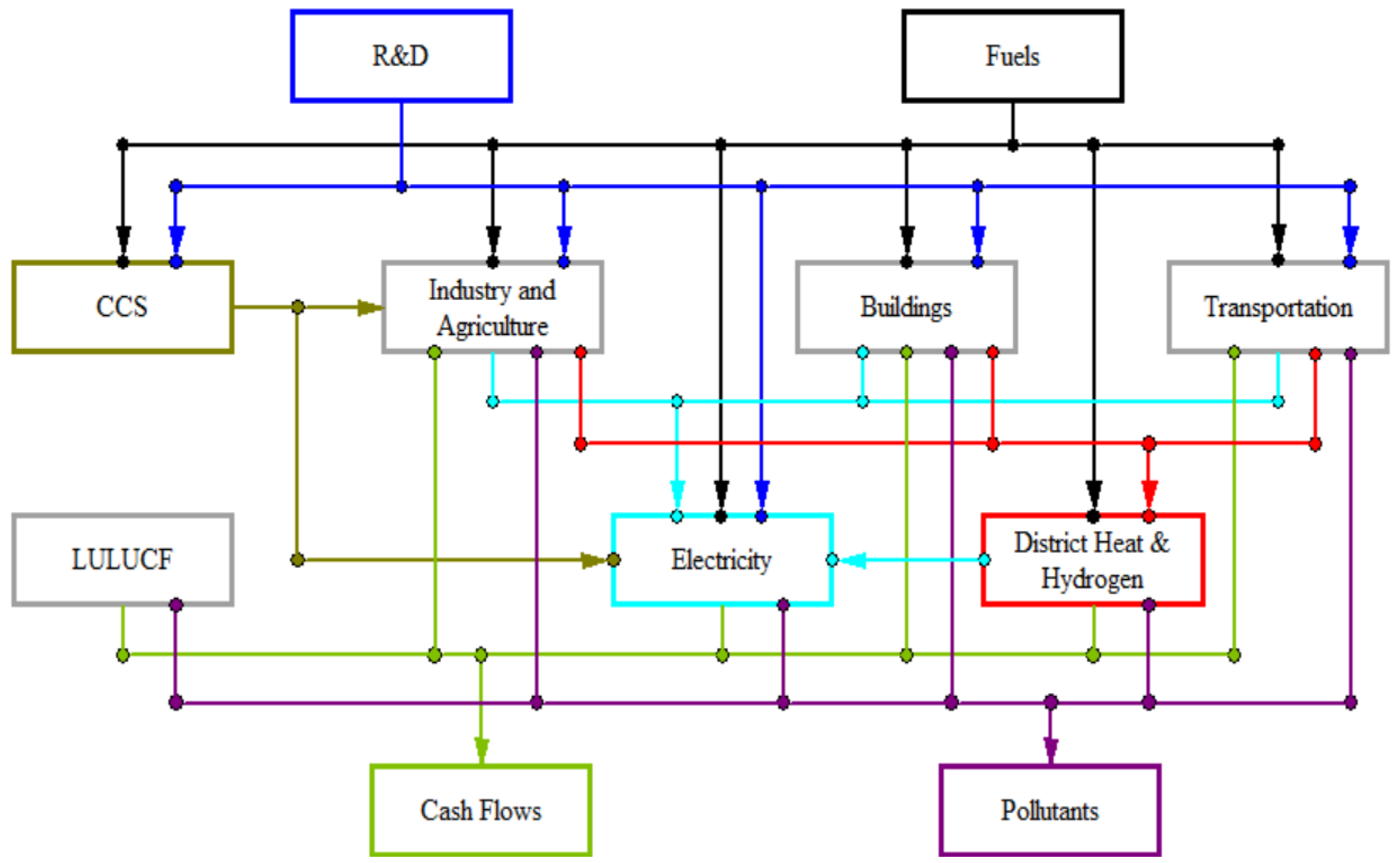
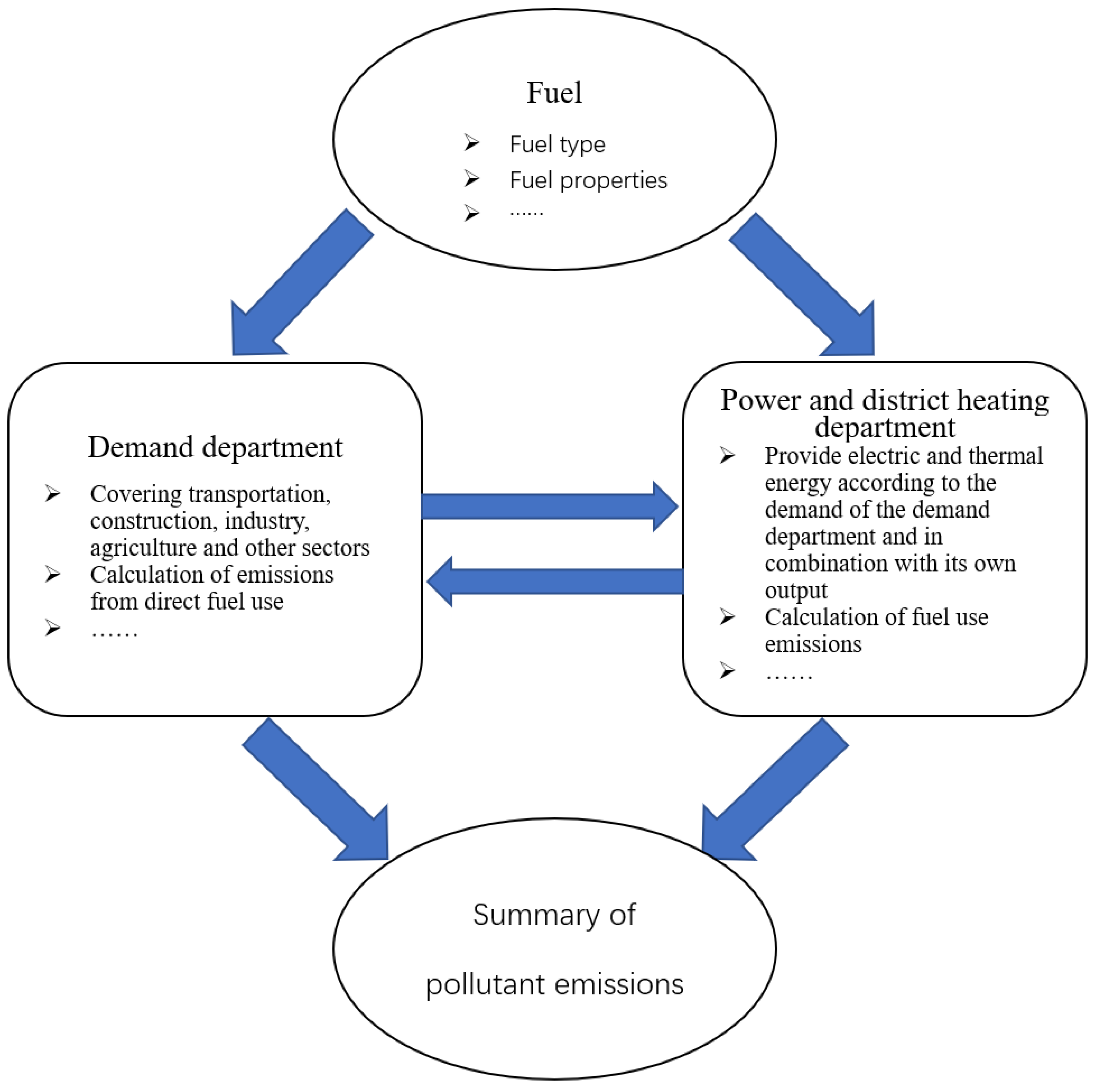

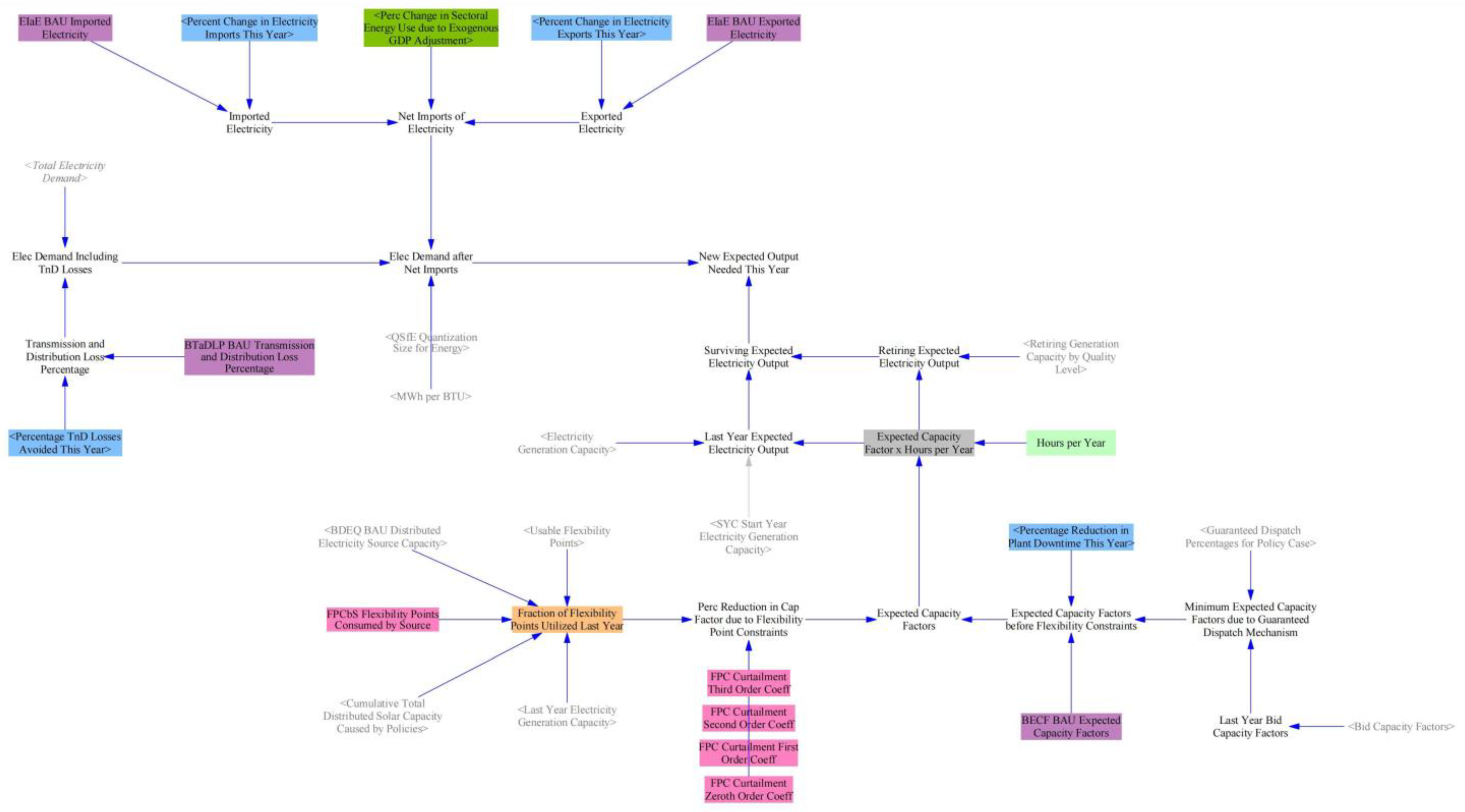
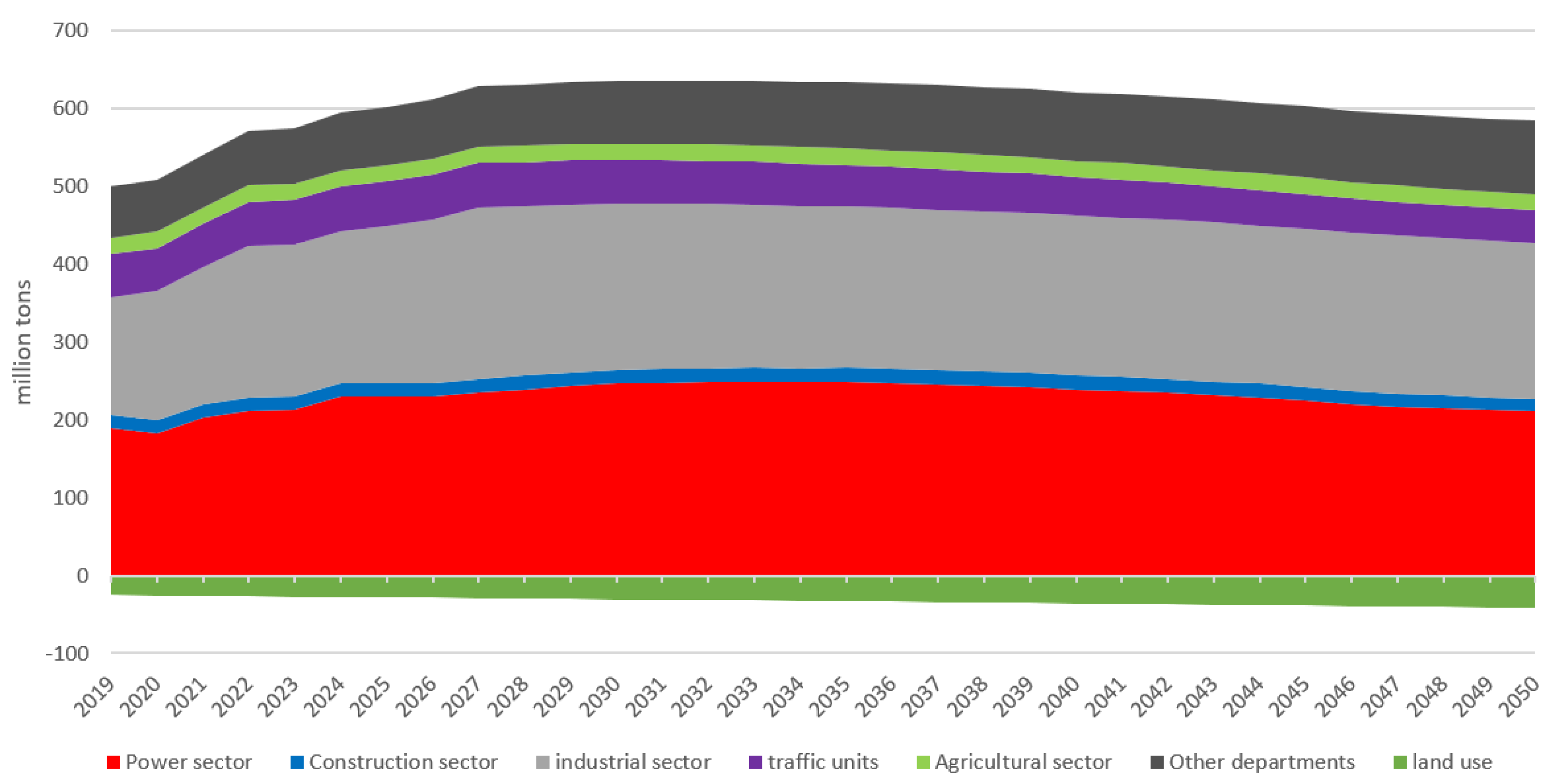
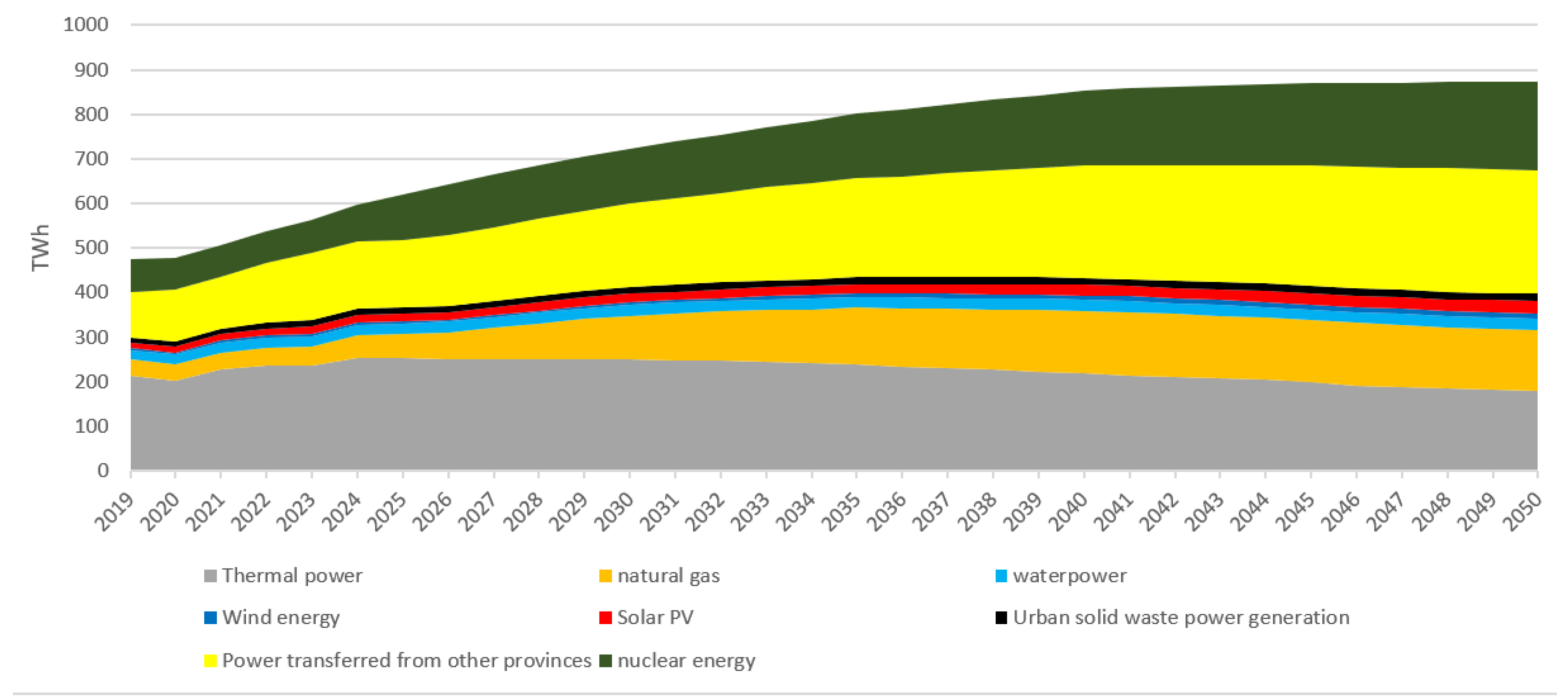


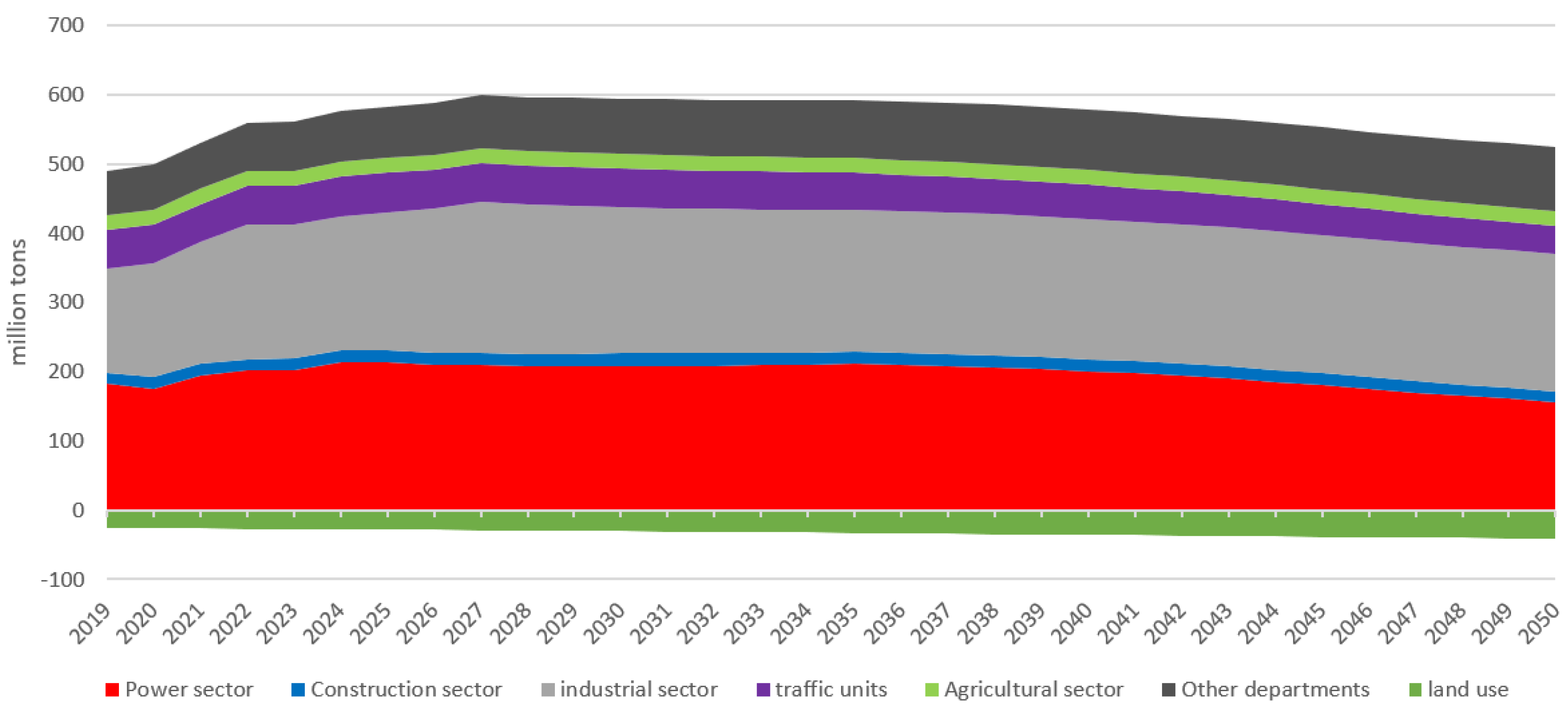
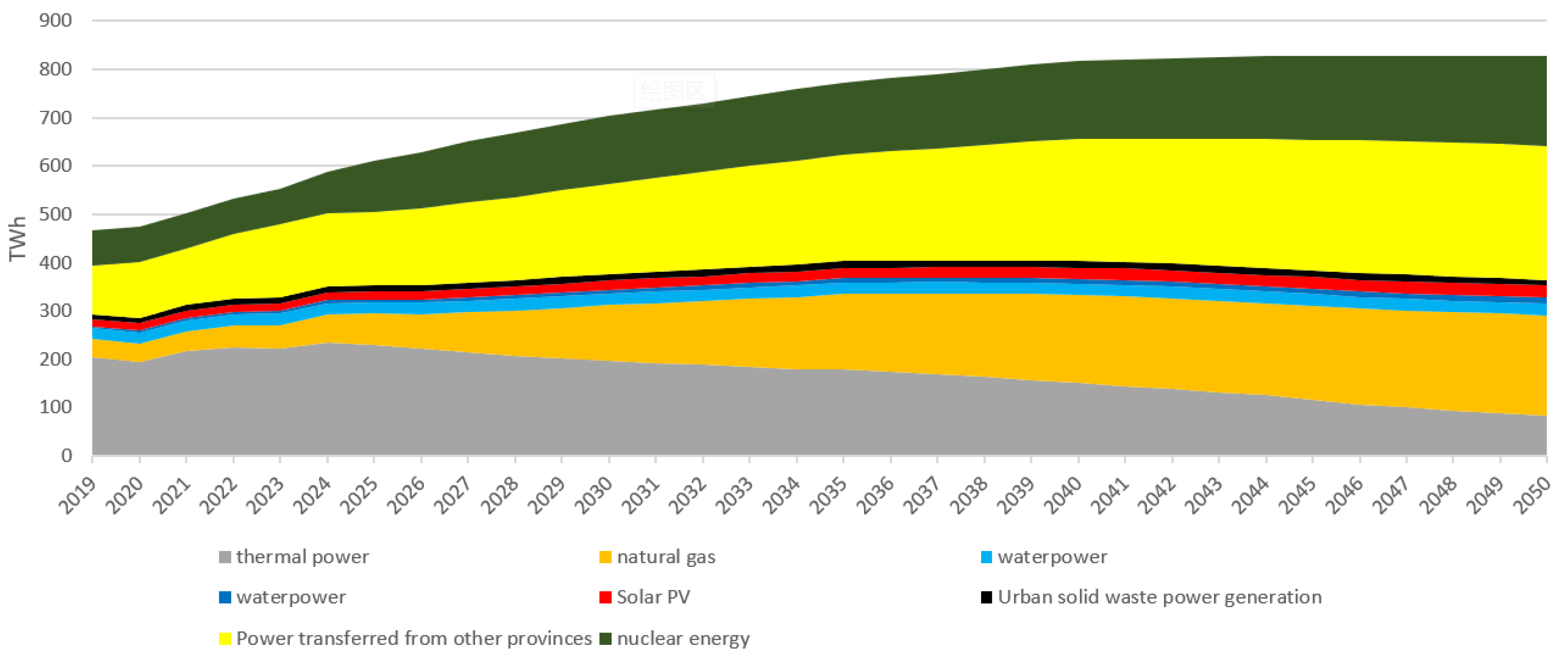

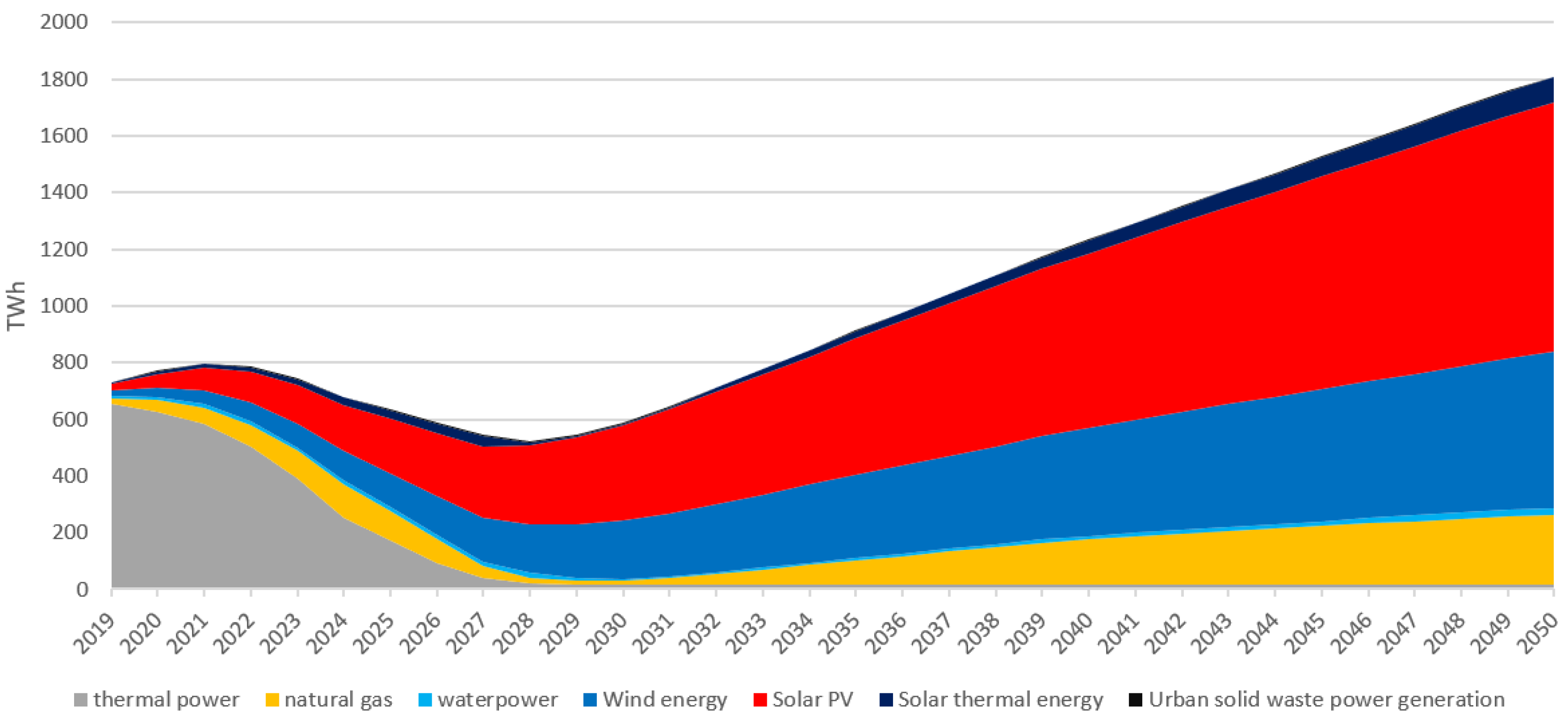
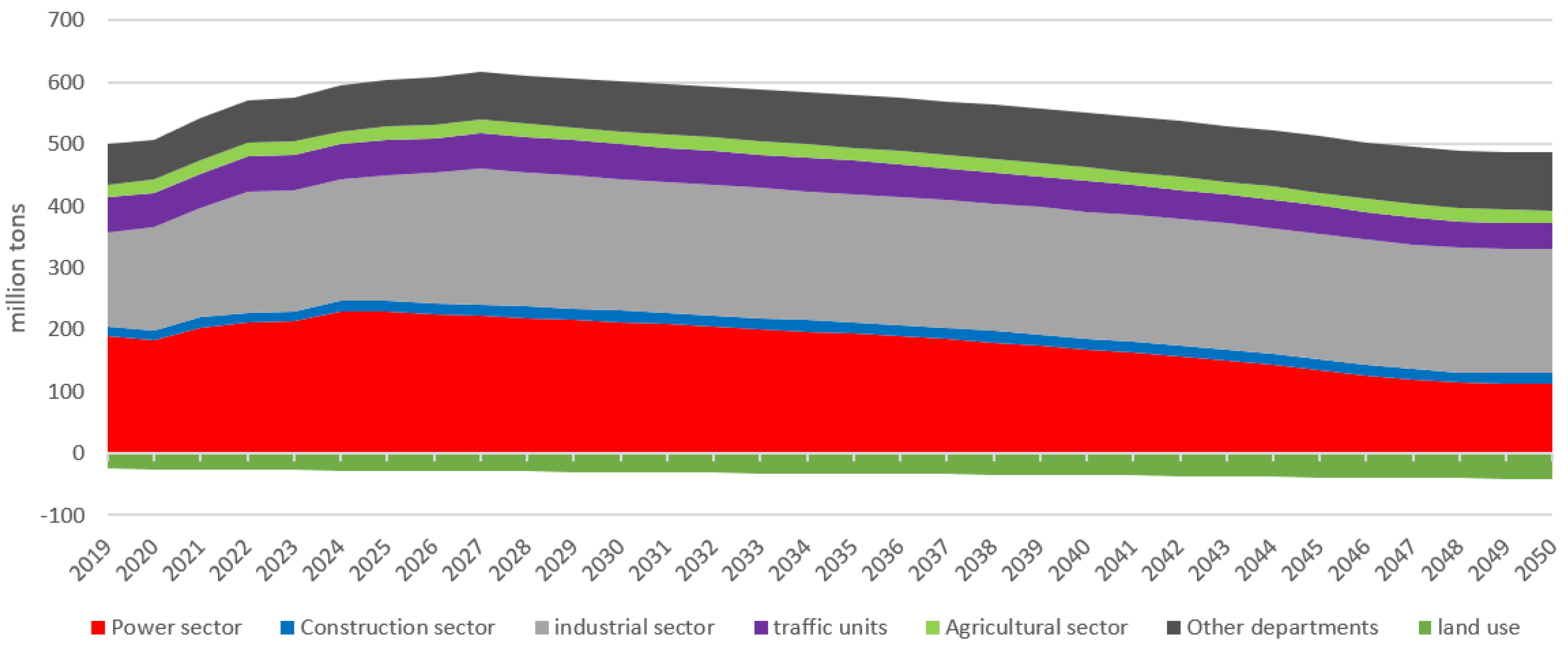
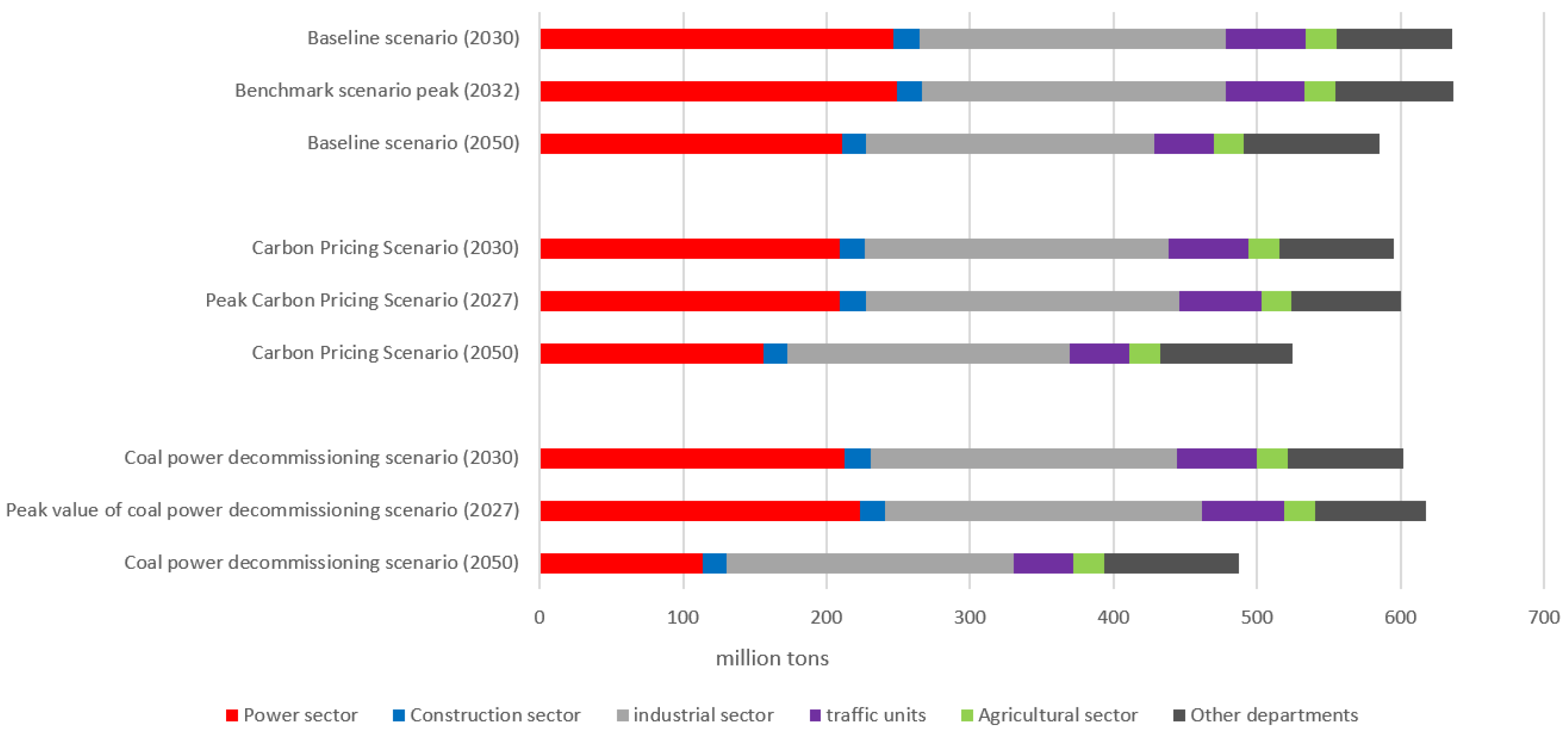
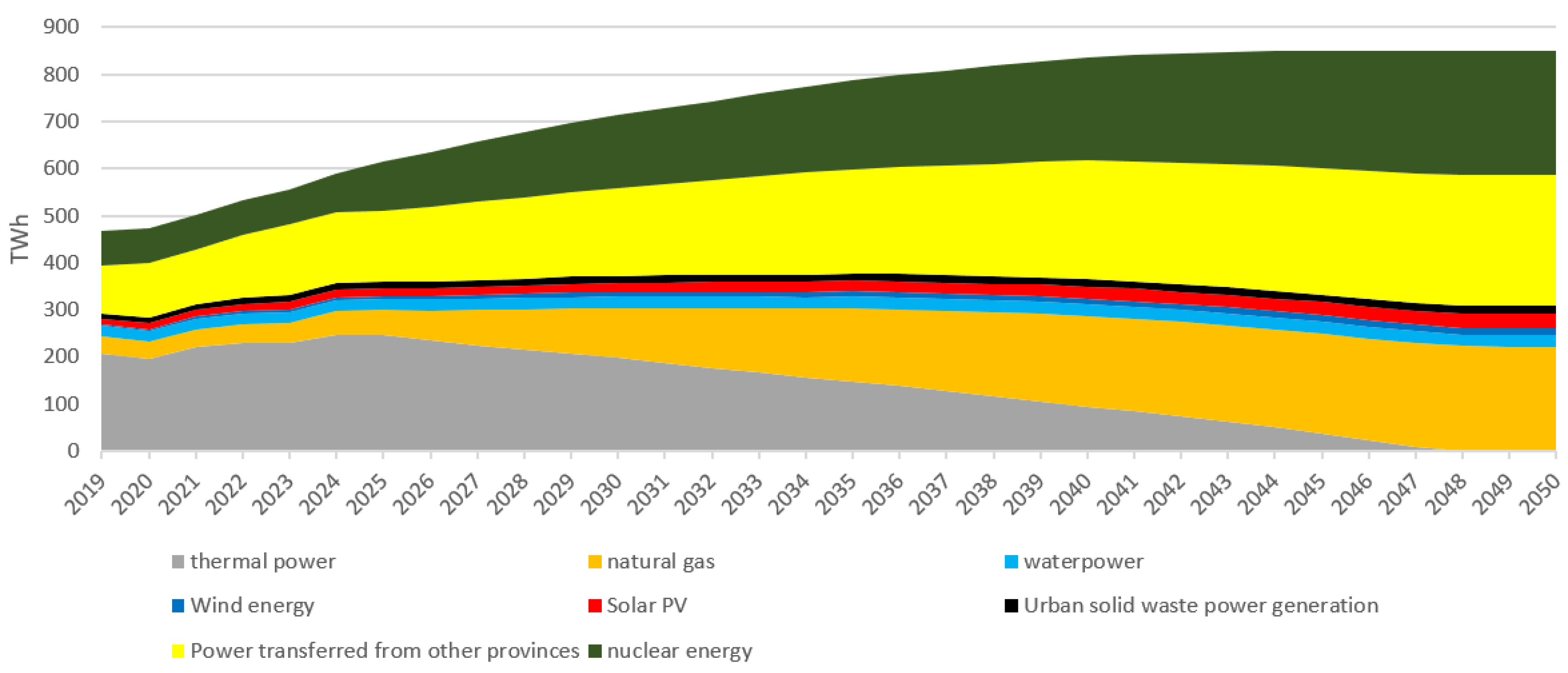
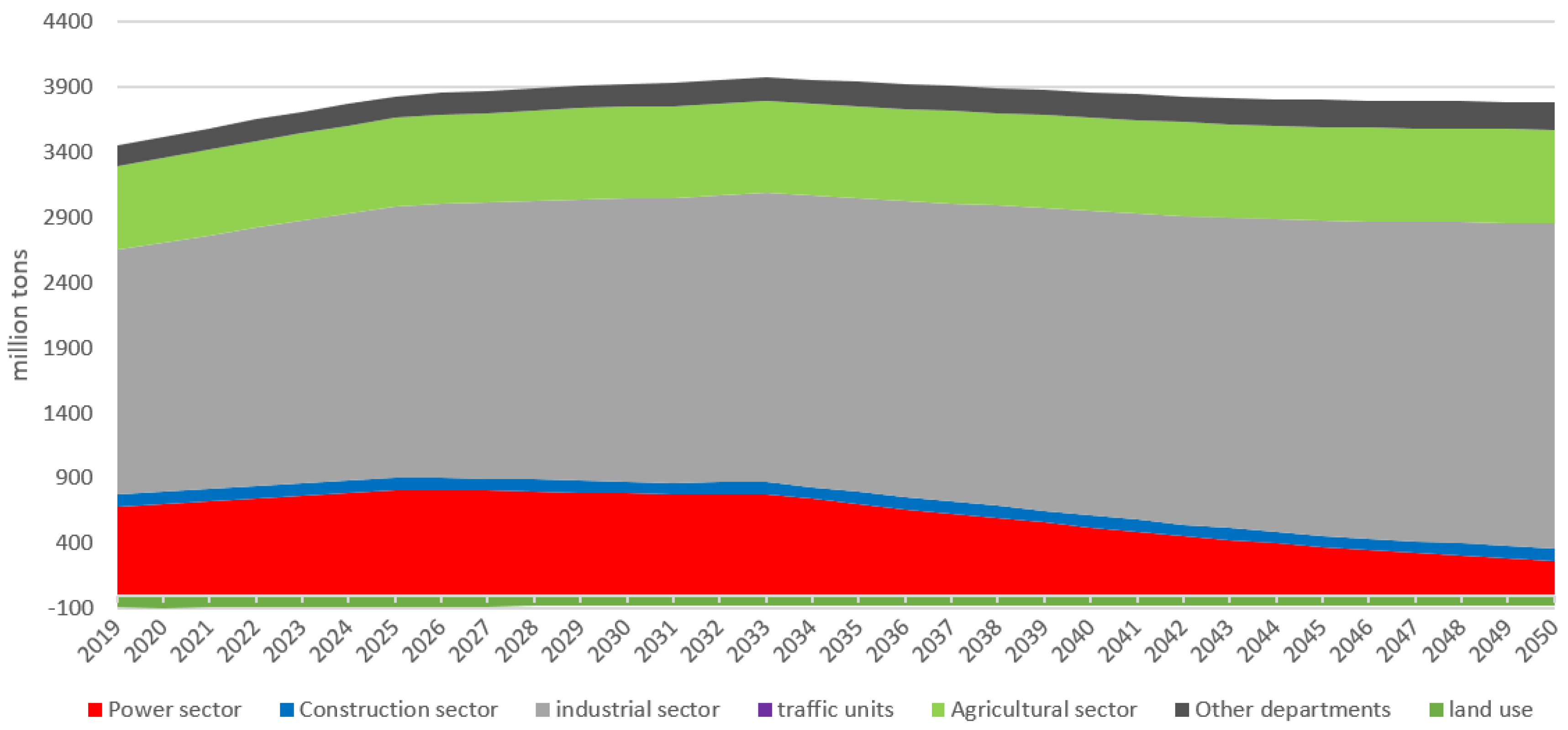

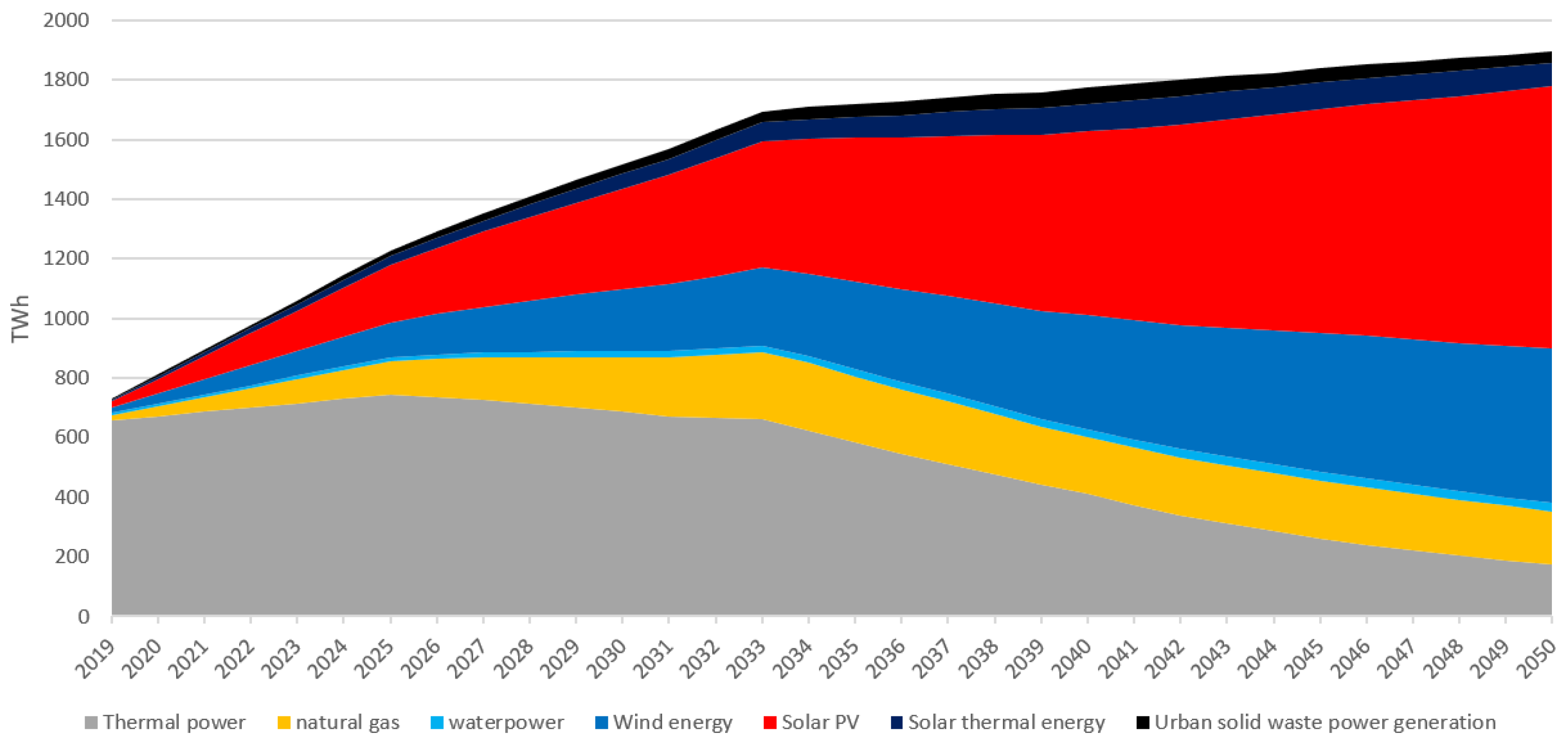
| Index | Zhejiang Province | Inner Mongolia Autonomous Region |
|---|---|---|
| Population (10,000) | 6456.8 | 2404.9 |
| Regional GDP (USD 100 million) | 9230.5 | 2480.0 |
| GDP per capita (USD 10,000/person) | 1.43 | 1.03 |
| Total import and export (USD 100 million) | 4834.0 | 150.2 |
| Total energy production (10,000 tons of standard coal, 2019) | 2937.0 | 64,214.7 |
| Total energy consumption (10,000 tons of standard coal, 2019) | 22,393.0 | 25,345.6 |
| Variable Name | Importance | Source |
|---|---|---|
| Amount spent on building components under the reference scenario | High | US EPS model, per capita GDP ratio of Inner Mongolia Autonomous Region and the US |
| US EPS model, per capita GDP ratio of Inner Mongolia Autonomous Region and the US | Very high | Research on Building Energy Saving Standards and Implementation Mechanism Based on Total Energy Consumption Control, Inner Mongolia Statistical Yearbook, American EPS Model, and the per capita GDP ratio of Inner Mongolia Autonomous Region and the United States |
| Future GDP growth | Very high | China Statistical Yearbook, IMF World Economic Outlook |
| Heating proportion of different fuel types under the reference scenario | High | Inner Mongolia Energy Balance Table 2017 |
| Retired unit capacity under the reference scenario | High | China Electricity Statistics Yearbook 2020 |
| Proportion of renewable energy power generation under the reference scenario | High | China Energy Statistics Yearbook 2019, China Power Statistics Yearbook 2020 |
| Transmission and distribution loss rate under the reference scenario | High | Inner Mongolia Statistical Yearbook 2018, Inner Mongolia Power Balance Sheet |
| Incoming and outgoing electric quantity of Inner Mongolia Autonomous Region | High | Inner Mongolia Statistical Yearbook 2018, Inner Mongolia Power Balance Sheet |
| Future maximum growth space of installed capacity | Very high | Relevant planning of Inner Mongolia Autonomous Region and consultation with relevant experts |
| Maximum potential installed capacity | High | Relevant planning of Inner Mongolia Autonomous Region and consultation with relevant experts |
| Initial annual installed capacity | High | China Electricity Statistics Yearbook 2020, China Energy Development Report 2017 |
| Flexibility of power generation equipment | Mid | CIGRE-related research results, and consult relevant experts |
| Forest carbon sink under the reference scenario | Very high | Inner Mongolia Statistical Yearbook 2018, statistical data of land resources in Inner Mongolia Autonomous Region, US EPS model |
| Potential land area affected by new policies within one year | Very high | Inner Mongolia Statistical Yearbook 2018, US EPS model, land area ratio between Inner Mongolia Autonomous Region and the US |
| Annual average mileage of different types of vehicles under the reference scenario | High | Wind database, Technical Guidelines for the Preparation of Air Pollutants Emission Inventory of Road Vehicles (Trial) issued by the Ministry of Ecology and Environment, Statistical Bulletin on the Development of China’s Civil Aviation Industry in 2015 |
| Subsidy proportion of electric vehicles under the reference scenario | High | Implementation Opinions on Accelerating the Promotion and Application of New Energy Vehicles of Inner Mongolia Autonomous Region |
| Minimum requirements for the proportion of electric vehicle sales under the reference scenario | High | Mongolia Autonomous Region, and Medium and Long term Development Plan of Automobile Industry of Ministry of Industry and Information Technology, and consult relevant experts |
| Proportion of vehicles owned by different entities | High | Inner Mongolia Statistical Yearbook 2018, China Public Transport Resources Atlas |
| Vehicle ownership in the starting year (2017) | Very high | Inner Mongolia Statistical Yearbook 2018, statistical bulletin on the development of civil aviation industry over the years, US EPS model |
Disclaimer/Publisher’s Note: The statements, opinions and data contained in all publications are solely those of the individual author(s) and contributor(s) and not of MDPI and/or the editor(s). MDPI and/or the editor(s) disclaim responsibility for any injury to people or property resulting from any ideas, methods, instructions or products referred to in the content. |
© 2023 by the authors. Licensee MDPI, Basel, Switzerland. This article is an open access article distributed under the terms and conditions of the Creative Commons Attribution (CC BY) license (https://creativecommons.org/licenses/by/4.0/).
Share and Cite
Duan, W.; Lin, G.; Xu, D. Can Inner Mongolia Learn from Zhejiang’s Low-Carbon Policy?—Comparative Analysis Based on the EPS Model. Atmosphere 2023, 14, 169. https://doi.org/10.3390/atmos14010169
Duan W, Lin G, Xu D. Can Inner Mongolia Learn from Zhejiang’s Low-Carbon Policy?—Comparative Analysis Based on the EPS Model. Atmosphere. 2023; 14(1):169. https://doi.org/10.3390/atmos14010169
Chicago/Turabian StyleDuan, Wei, Guilei Lin, and Desheng Xu. 2023. "Can Inner Mongolia Learn from Zhejiang’s Low-Carbon Policy?—Comparative Analysis Based on the EPS Model" Atmosphere 14, no. 1: 169. https://doi.org/10.3390/atmos14010169
APA StyleDuan, W., Lin, G., & Xu, D. (2023). Can Inner Mongolia Learn from Zhejiang’s Low-Carbon Policy?—Comparative Analysis Based on the EPS Model. Atmosphere, 14(1), 169. https://doi.org/10.3390/atmos14010169








